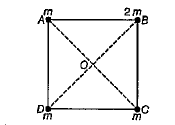When…………..acts on a system of particles, then………….of the system remains…………… .
To solve the question, we need to fill in the blanks based on the principles of rotational motion and angular momentum. Here’s the step-by-step solution:
Step 1: Identify the Condition
We start by identifying the condition under which the system of particles is being analyzed. The key phrase is "when no external torque acts on a system of particles."
Fill in the first blank:
"When no external torque acts on a system of particles..."
Step 2: Determine the Effect on Angular Momentum
Next, we need to determine what happens to the angular momentum of the system when no external torque is applied. According to the law of conservation of angular momentum, if no external torque acts on a system, the angular momentum remains constant.
Fill in the second blank:
"...then angular momentum of the system..."
Step 3: State the Conservation Principle
Finally, we conclude by stating that the angular momentum remains unchanged or conserved.
Fill in the third blank:
"...remains conserved."
Final Answer
Putting it all together, we have:
"When no external torque acts on a system of particles, then angular momentum of the system remains conserved."
---
We start by identifying the condition under which the system of particles is being analyzed. The key phrase is "when no external torque acts on a system of particles."
"When no external torque acts on a system of particles..."
Next, we need to determine what happens to the angular momentum of the system when no external torque is applied. According to the law of conservation of angular momentum, if no external torque acts on a system, the angular momentum remains constant.
"...then angular momentum of the system..."
Finally, we conclude by stating that the angular momentum remains unchanged or conserved.
"...remains conserved."
Putting it all together, we have:
"When no external torque acts on a system of particles, then angular momentum of the system remains conserved."
Topper's Solved these Questions
- SYSTEMS OF PARTICLES AND ROTATIONAL MOTIONBOOK - PRADEEPCHAPTER - SYSTEMS OF PARTICLES AND ROTATIONAL MOTIONEXERCISE - PROBLEMS FOR PRACTICE TYPE A
2 Videos
- SYSTEMS OF PARTICLES AND ROTATIONAL MOTIONBOOK - PRADEEPCHAPTER - SYSTEMS OF PARTICLES AND ROTATIONAL MOTIONEXERCISE - PROBLEMS FOR PRACTICE
69 Videos
- SYSTEMS OF PARTICLES AND ROTATIONAL MOTIONBOOK - PRADEEPCHAPTER - SYSTEMS OF PARTICLES AND ROTATIONAL MOTIONEXERCISE - MULTIPLE CHOICE QUESTIONS
151 Videos
- RAY OPTICSBOOK - PRADEEPCHAPTER - RAY OPTICSEXERCISE - Problem For Practice(a)
25 Videos
- THERMODYNAMICSBOOK - PRADEEPCHAPTER - THERMODYNAMICSEXERCISE - Assertion- Reason Type Questions
19 Videos
Similar Questions
Knowledge Check
Figure shows the initial position of a system of two particles. Given that centre of mass of the system remains at rest particle A moves i a trajectory givenn by x2a2+y2b2=1
Pick the correct option (s) for the nature of B's trajectory and the coordinates of B at the instant when A was at the position (0,b).
 ATrajectory of B is ellipticalBTrajectory of B is circularC(0,−b2)D(a2,−b2)
ATrajectory of B is ellipticalBTrajectory of B is circularC(0,−b2)D(a2,−b2)For a system of particles if = 0, then choose the correct option.
AdLdt=constant≠0BI=constantCL=constantDNone of the aboveConsider the following statements
I. If net external force on a system of particles is zero, the total linear momentum of the system will remain conserved
II. If net external force on a system of particles is zero, the velocity of the centre of mass of the system must remain constant. Choose the correct option.AOnly I Is correctBOnly II Is correctCBoth the statements are correctDBoth the statements are incorrect
Internal forces acting in a system of particle can change
View SolutionThe reference frame, in which the centre of inertia of a given system of particles is at rest, translates with a velocity V relative to an inertial reference frame K. The mass of the system of particles equals m, and the total energy of the system in the frame of the centre of inertia is equal to ˜E. Find the total energy E of this system of particles in the reference frame K.
View SolutionCM of the given system of particles will be at

View SolutionCM of the given system of particles will be at

View SolutionThe centre of mass of a system of particles does not depend on
View Solution
